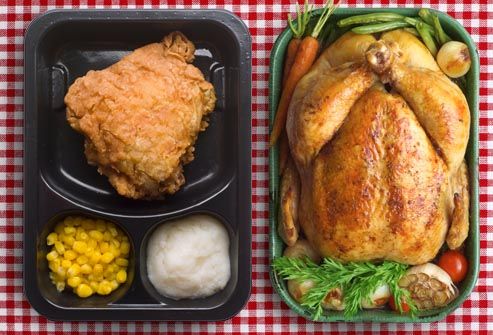7 Tips for Tasty, Diabetes-Friendly Meals
Reviewed by Kathleen M. Zelman, MPH, RD, LD
You can have delicious food that meets your needs for managing yourtype 2 diabetes. You have more options than you may realize.
“It all comes down to having the right ingredients on hand for making meals both diabetes-friendly and delicious,” says Jackie Newgent, RD, author of The With or Without Meat Cookbook: The Flexible Approach to Flavorful Diabetes Cooking.
Use these seven ideas to liven up your standby dishes in a flash.
1. Try the half-and-half pasta trick.
Pasta is a favorite dish for many people. It's no secret that the whole-grain versions are the most nutritious. They’re rich in vitamins, minerals, phytochemicals, and fiber, which helps with digestion, makes you feel full, and doesn’t raise blood sugar as much as white pasta does.
If whole wheat spaghetti doesn’t whet your appetite, dietitian Bonnie Taub-Dix recommends mixing some (no more than half) white semolina pasta with it.
Also, cut veggies like zucchini, squash, and carrots into spaghetti-like strips using a mandolin slicer or a spiralizer. Top it off with a few meatballs or some chicken, so you'll eat less of the pasta and get some protein with your meal, says Taub-Dix, author of Read It Before You Eat It.
2. Shake up a spicy blend.
Empty your saltshaker, and fill it with a mix of your favorite seasonings and spices. Use it to liven up eggs, salads, poultry, lean meats, and veggies, Taub-Dix suggests.
Brands sold online and in supermarkets have a variety of flavorful and aromatic blends, including Italian, Southwest chipotle, or a garlic- or peppercorn-based blend.
Choose the salt-free versions. Most people get too much sodium, which can make you more likely to get high blood pressure.
3. Pick pistachios.
You'll get fiber and protein, as well as several vitamins, minerals, andphytonutrients. “Also, research indicates that pistachios may help decrease the blood sugar response in the body when coupled with a carbohydrate,” Newgent says.
Pistachios can be more than just a crunchy snack. Add them to a brown rice pilaf or a salad, Newgent suggests.
4. Replace fatty foods with avocado.
Avocados are rich in fat, but it's a good kind of fat.
“Eating healthful fats, as part of a Mediterranean diet, may be beneficial for blood sugar management, and potentially more helpful than a low-fat diet for weight management,” Newgent says.
Avocados are also a good source of magnesium, Newgent says.
She mentions a study in which people with prediabetes who had more magnesium in their diets were less likely to develop type 2 diabetes. That study doesn't prove that magnesium was the reason, but the researchers concluded that the magnesium may have been helpful.
Still, avocados are high in calories, so limit how much you eat.
Try pairing eggs with sliced avocado, or dot a dollop of guacamole on a lean, grilled steak.
5. Get creative with yogurt.
“Plain Greek yogurt shouldn’t just be considered a creamy, high-protein breakfast or snack. It can be a delicious ingredient in cuisine as well,” Newgent says.
She suggests pairing yogurt with lemon juice, garlic, and a touch of extra-virgin olive oil for use as a marinade on chicken. “It’ll make the poultry extra juicy when roasted or grilled.”
6. Sprinkle on the cinnamon.
Considered one of the world’s oldest-known spices, cinnamon has been studied for possible health benefits for people who have type 2 diabetes. Though the findings have been mixed, Newgent says, “a recent study shows enjoying it may help decrease blood sugar, ‘bad’cholesterol (LDL), and triglycerides in the body.” Don't expect it to make a huge difference in normal portions. It's still more of a flavoring than anything else.
Mix cinnamon into a turkey burger (“add fresh mint, too, for a Middle Eastern flair," Newgent says), or a vegetable chili, or add it to a baked sweet potato, cottage cheese, or an apple you're going to heat in the oven or microwave.
7. Glaze your snacks and desserts.
While you’ll only use a small amount, some research shows that vinegar may lower blood sugar. You can get balsamic glazes online and in supermarkets. Drizzle them on pizza, fish, meats, veggies, or fruit.
“I love to drizzle a balsamic glaze on top of berries or melon,” Taub-Dix says. “You’ll be surprised how that little glaze can make a difference in how your fruit looks and tastes. It just gives it a little jazz!”





















